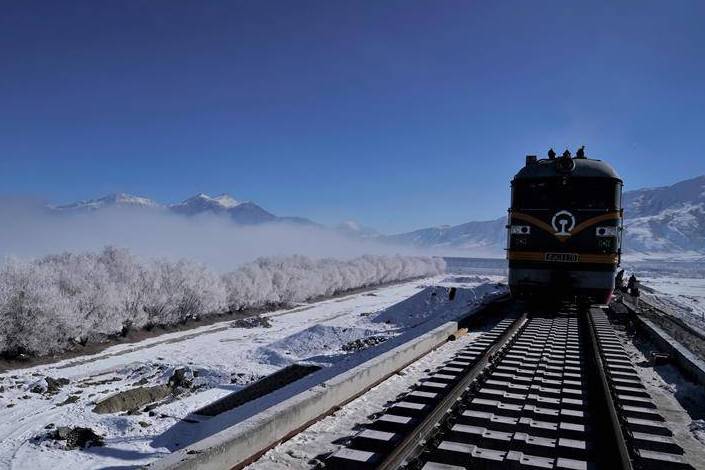At a time when India has teamed up with the US-led QUAD bloc to counter China, Beijing is preparing to run bullet trains close to the Indian border in Arunachal Pradesh.
And, if everything goes as planned, this high-speed railway link to Tibet’s capital Lhasa will be operationalized by July this year, according to reports.
Besides, the communist nation is planning to create a “passageway” from the Tibet Autonomous Region to South Asia, India’s neighborhood. The project found a mention in the country’s 14th plan document that was submitted to China’s Parliament, the National People’s Congress (NPC), last month.
Earlier, there were reports that China was planning a Trans-Himalayan Multi-Dimensional Connectivity Network linking Kathmandu in Nepal and Shigatse in Tibet as part of its Belt and Road Initiative (BRI). The move is aimed at boosting trade and tourism prospects for Nepal, and easing its reliance on India.
If this is what China meant by its ‘South Asia passageway’, then it must ring alarm bells among Indian policymakers. China anyway wields greater influence in the tiny Himalayan nation because of its investments in many sectors than India.
Ever since Nepal Communist Party came to power, Beijing has been closely involved in Nepal’s affairs in the garb of providing economic and developmental assistance to the country battered by the decade-long Maoist insurgency – from 1996 to 2006.
China overtook India as the biggest foreign investor in 2014. Almost 90% of FDI in the last fiscal has come from China and Beijing had promised $500-million assistance to Nepal in October 2019, according to German News agency DW.

China has invested heavily in infrastructure and hydropower projects with Nepal being a partner in Beijing’s Belt and Road Initiative (BRI), a global connectivity and infrastructure development project through which President Xi Jinping wants to create, what Portuguese political scientist and author Bruno Macaes, calls a ‘Chinese world order’.
Bullet Trains To Tibet
According to the Chinese news agency Xinhua, the construction of the high-speed railway line began in 2014. This is the first electrified rail route in Tibet connecting the capital Lhasa (11,800 ft) with Nyingchi in the same province.
The 435-km track was completed just a few months back. Powered by both internal combustion and electricity, Fuxing trains will run at a speed of 160 km per hour. The home-grown Fuxing trains have a speed range of 160-350 km per hour.
Lu Dongfu, chairman of China State Railway Group Company Limited, said the total length of China’s high-speed train network could be extended to around 50,000 km by 2025, up from 37,900 km by the end of 2020, covering 98 percent of the Chinese cities.
It is worth mentioning that China has rapidly improved infrastructure in areas close to the Line of Actual Control, its de facto border with India.
It has expanded the railway network connecting the remote parts of Tibet with mainland China, a move to assert Beijing sovereignty and supremacy and counter Western narrative in support of the Tibetans’ right to self-determination.
How Is India Faring?
In contrast, India’s border infrastructure is limited to building roads, bridges, and a few tunnels only. A vast area of Arunachal Pradesh in India’s strategically important Northeast, is still devoid of proper road links let alone railway tracks. China claims the whole of Arunachal as its territory, calling it Southern Tibet.
In 2015, India had extended the rail network up to Arunachal’s Naharlagun, just across the Assam border. Since then there has been little progress to extend the network even as there has been a bombardment of development on the Tibet side.
Even Arunachal chief minister Pema Khandu stressed the need to link the beautiful town of Tawang, which houses the world’s second-largest monastery, with a railway network.
In a meeting with a central team last September, Khandu reportedly said Arunachal Pradesh, especially the Tawang district, is much disputed by China, and railways reaching the farthest districts would be a befitting reply to the ‘claims’.
Last month, India’s federal government informed a parliamentary committee that the government is undertaking a “standalone project” in Ladakh to build a critical road along the China border.
In addition, the construction of 57 roads, construction and refurbishing of 32 helipads, development of 47 outposts, and 12 staging camps for Indo-Tibetan Border Police (ITBP) along with the construction of 18-foot tracks in Arunachal Pradesh are currently underway.
India, for that matter QUAD, may be firming up strategies to counter China in the Indo-Pacific region, but New Delhi must not lose sight of China’s fast-paced development work in the border region. For, the Chinese doctrine is based not only on military tactics, but it also includes elements of psychological warfare.
For instance, if China can establish a village deep inside India’s territory in Arunachal Pradesh, it can also brainwash the locals (Indians) and make them adopt and emulate the “Chinese culture”, which would be like abandoning their Indian identity.
In January, The Eurasian Times reported how Chinese radio broadcast is clearly audible as far as Assam. A professor of Assam’s Dibrugarh University then posted a tweet, saying, “The radio propaganda needs to be juxtaposed with the scenario of #AIR stations here either getting shut or sized down. Stronger reception of radio China compared to Indian stations.”




